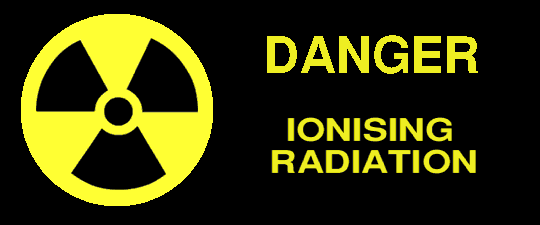

Ionizing radiation can affect any cell within the body, but rapidly dividing cells are more likely to suffer lasting damage. Thus stem cells that produce white blood cells within bone marrow are especially vulnerable. This results in loss of defence from infectious diseases. Acute radiation doses (those doses received in one 'blast') between 2 and 8 sieverts can sufficiently damage blood cell production to result in death. Consumption of anti-oxidants such as vitamic C and E prior to radiation exposure can help protect against radiation damage. High doses of vitamin E have been shown to prevent death from radiation in animals, presumably by mopping up free radicals generated by the radiation and which would otherwise cause havoc in the cell.
ALPHA RADIATION Alpha particles, being Helium-4 nuclei, are large, heavy and carry a double positive charge, hence they travel relatively slowly, and quickly lose energy when encountering matter, whose atoms it ionises. Typically they can penetrate only 1/1000th centimetre in aluminium.
BETA RADIATION Being electrons, which are negatively charged but light-weight particles, beta radiation travels at near the speed of light and ionises matter much less readily. They can penetrate 1/10th centimetre into aluminium.
POSITRON RADIATION Because positrons are anti-electrons, mutual annihilation occurs when they encounter the electrons in ordinary matter, resulting in the production of gamma radiation, and is the basis of medical positron emission tomography, or PET scanners.
GAMMA RADIATION Gamma radiation, being essentially high-energy light rays, travel at the speed of light and are highly penetrative, travelling through 10cm of aluminium, and present the greatest radiation hazards. Because gamma rays are highly energetic photons, they are usually generated by nuclear processes and nuclear energy transitions, and not by the electronic transitions of by the electrons in an atom, which usually generate lower energy X-ray photons, or even lower energy visible light-ray photons.
NEUTRON RADIATION Being heavy but chargeless, neutrons penetrate some materials relatively easily but are absorbed strongly by hydrogenous material. To living biological tissue, neutrons are roughly 10 to 100 times as damaging as are gamma rays of the same dose.
NEUTRINO RADIATION Because neutrinos are extremely light or perhaps massless and without charge, they are highly penetrating, travelling at near light speed, but harmless. The neutrino flux from the sun of approx 70×109 per square cm/s passes straight through the Earth with extremely small perceptible absorption.
![]()